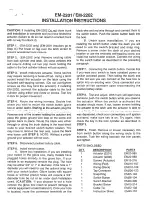
230
STARTING AND OPERATING
If the vehicle is equipped with air suspension,
the engine should be started and left running for
a minimum of 60 seconds (with all the doors
closed) at least once every 24 hours. This
process allows the air suspension to adjust the
vehicle’s ride height to compensate for
temperature effects.
Shifting Out Of N (Neutral)
Use the following procedure to prepare your
vehicle for normal usage:
1. Bring the vehicle to a complete stop, leaving
it connected to the tow vehicle.
2. Press and hold the brake pedal.
3. Start the engine. Apply the parking brake. Shift
the transmission into NEUTRAL.
4. Using a ballpoint pen or similar object, push
and hold the recessed transfer case N
(Neutral) button (at the center of the transfer
case switches).
5. When the N (Neutral) indicator light turns off,
release the N (Neutral) button.
6. Turn the engine off. The transmission will
automatically select PARK when the engine is
turned off.
7. Release the brake pedal.
8. Disconnect vehicle from the tow vehicle.
9. Press and hold the brake pedal.
10. Start the engine.
11. Release the parking brake.
12. Shift the transmission into DRIVE, release the
brake pedal, and check that the vehicle
operates normally.
NOTE:
Steps 3 and 4 are requirements that must be
met before pushing the button to shift out of
N (Neutral), and must continue to be met until
the shift has been completed. If any of these
requirements are not met before pushing the
button or are no longer met during the shift, the
N (Neutral) indicator light will flash continuously
until all requirements are met or until the button
is released.
The ignition must be in the ON/RUN mode for a
shift to take place and for the position indicator
lights to be operable. If the ignition is not in the
ON/RUN mode, the shift will not take place and
no position indicator lights will be on or flashing.
A flashing N (Neutral) position indicator light
indicates that shift requirements have not been
met.
DRIVING TIPS
D
RIVING
O
N
S
LIPPERY
S
URFACES
Acceleration
Rapid acceleration on snow covered, wet, or other
slippery surfaces may cause the driving wheels to
pull erratically to the right or left. This phenomenon
occurs when there is a difference in the surface
traction under the rear (driving) wheels.
WARNING!
Rapid acceleration on slippery surfaces is
dangerous. Unequal traction can cause sudden
pulling of the rear wheels. You could lose control
of the vehicle and possibly have a collision.
Accelerate slowly and carefully whenever there
is likely to be poor traction (ice, snow, wet, mud,
loose sand, etc.).
22_DT_OM_EN_USC_t.book Page 230
Содержание 1500 2022
Страница 108: ...106 GETTING TO KNOW YOUR INSTRUMENT PANEL BASE MIDLINE INSTRUMENT CLUSTER GASOLINE 22_DT_OM_EN_USC_t book Page 106...
Страница 110: ...108 GETTING TO KNOW YOUR INSTRUMENT PANEL PREMIUM INSTRUMENT CLUSTER GASOLINE 22_DT_OM_EN_USC_t book Page 108...
Страница 112: ...110 GETTING TO KNOW YOUR INSTRUMENT PANEL BASE MIDLINE INSTRUMENT CLUSTER DIESEL 22_DT_OM_EN_USC_t book Page 110...
Страница 115: ...GETTING TO KNOW YOUR INSTRUMENT PANEL 113 PREMIUM INSTRUMENT CLUSTER DIESEL 3 22_DT_OM_EN_USC_t book Page 113...
Страница 452: ...450 SERVICING AND MAINTENANCE 22_DT_OM_EN_USC_t book Page 450...















































